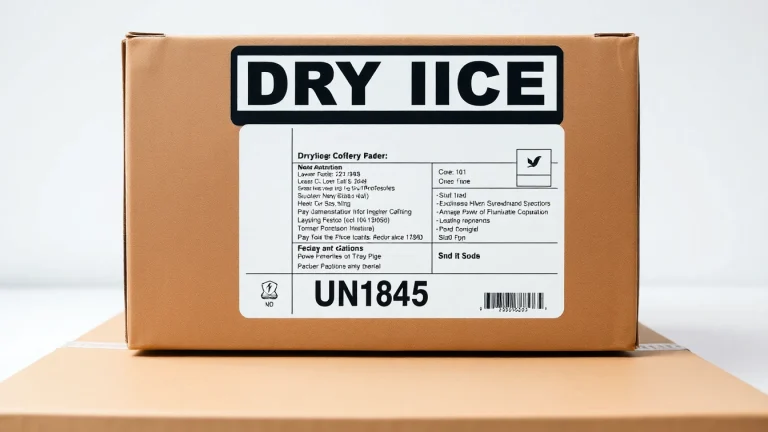
Essential Guide to Dry Ice Label Requirements for Safe Shipping
Understanding Dry Ice Labels and Their Significance
Transporting dry ice safely requires adherence to specific regulations and guidelines, including the use of a dry ice label. This article delves into every aspect of dry ice labels, providing essential knowledge for anyone involved in shipping or handling dry ice products.
What is a Dry Ice Label?
A dry ice label is an essential component of the packaging used for shipping dry ice, which is classified as a hazardous material. The specific designation for dry ice in the shipping world is UN1845, which refers to its classification under the United Nations number system for dangerous goods. This label communicates vital information including the contents of the shipment, handling precautions, and regulatory compliance.
Importance of Proper Labeling
Proper labeling of packages containing dry ice is crucial for several reasons:
- Safety: Dry ice can cause severe skin burns and forms carbon dioxide gas as it sublimates. A clear label ensures handlers know to exercise caution.
- Regulatory Compliance: The Department of Transportation (DOT) mandates labeling for dry ice shipments, and failure to comply can lead to fines and safety violations.
- Efficient Transportation: Labels help logistics and shipping companies quickly identify the contents, allowing them to apply the necessary precautions during transport and storage.
Common Misunderstandings about Dry Ice Labels
There are several misconceptions regarding dry ice labels that need clarification:
- All Labels are Created Equal: Not all labels comply with DOT regulations; proper specifications must be followed to ensure compliance.
- Labeling is Optional: In fact, labeling is a legal requirement for shipping dry ice. Failing to label appropriately could lead to hazardous situations.
- Digital Labels are Allowed: While you can create printable labels, they must meet specific physical standards and guidelines as outlined by regulatory agencies.
Components of a Dry Ice Label
Required Information on a Dry Ice Label
A compliant dry ice label must include the following information:
- Proper Shipping Name: This generally states “Dry Ice” or “Carbon Dioxide, solid.”
- UN Number: The label must show the UN number for dry ice, which is UN1845.
- Net Weight: The net weight of the dry ice in kilograms must be printed on the label.
- Handling Instructions: It is advisable to include any relevant handling instructions or risk warnings.
Design Specifications for Compliance
The design of a dry ice label is not arbitrary; it must adhere to specific guidelines set forth by the DOT and other regulatory bodies. For instance:
- The label must be at least 100 mm on a side.
- The background color is typically white with black text in a diamond shape to comply with identification standards.
Visual Elements of an Effective Dry Ice Label
An effective dry ice label employs visual elements that facilitate quick recognition and comprehension:
- Color Coding: Utilizing colors that signify caution (such as yellow or red) can help emphasize the potential risks associated with dry ice.
- Symbols: Incorporating internationally recognized hazard symbols can enhance understanding across different languages and cultures.
- Clear Fonts: Using bold, legible fonts ensures that critical information is readable even from a distance.
How to Create Your Own Printable Dry Ice Label
Tools and Software for Label Creation
Creating a printable dry ice label can be accomplished using various software tools and platforms:
- Graphic Design Software: Programs like Adobe Illustrator and CorelDRAW allow for detailed design capabilities.
- Label Design Software: Specialized software such as Bartender and NiceLabel are beneficial for creating compliance labels.
- Online Templates: Many websites offer downloadable templates specifically designed for dry ice labels.
Step-by-Step Printing Guide
Follow these steps to create and print your dry ice label:
- Choose a template that meets dry ice label specifications.
- Input the required information: Proper shipping name, UN number, net weight, and any handling precautions.
- Ensure the design meets all regulations regarding size, color, and font.
- Print using a durable material, such as vinyl or synthetic label stock, to withstand environmental conditions.
Ensuring Quality and Durability
Labels must be durable enough to survive transportation conditions. To achieve this:
- Use high-quality adhesive materials that can stick to various types of packaging.
- Consider weatherproof label materials if your shipment could be exposed to moisture or extreme temperatures.
- Apply a protective coating to the printed label to prevent fading or smearing.
Compliance and Regulations for Shipping Dry Ice
Understanding DOT Regulations
The Department of Transportation (DOT) regulates transportation and labeling of hazardous materials, including dry ice. Familiarity with these regulations is crucial for compliance:
- Shipping Weight Limits: Packages containing dry ice must not exceed 200 kilograms net weight per package.
- Label Placement: The dry ice label should be affixed to the outermost packaging, which should be marked on the vertical side.
- Emergency Procedures: Detailed instructions for handling emergencies should be provided, if necessary, particularly in medical or laboratory shipping.
Consequences of Non-Compliance
Not adhering to labeling and packaging regulations carries significant repercussions, including:
- Fines and penalties associated with violating DOT regulations.
- Liability for damages or injuries that result from improperly labeled shipments.
- Negative impacts on business reputation and loss of customer trust.
Best Practices for Shipping with Dry Ice
Adopting best practices can drastically enhance safety and compliance:
- Conduct regular training for staff involved in packaging and shipping.
- Utilize quality materials for packaging to prevent leaks or contamination.
- Implement a thorough labeling review process before shipment.
Frequently Asked Questions about Dry Ice Labeling
Common Concerns and Misconceptions
Several questions frequently arise concerning dry ice labeling:
- What label is required for dry ice? A Class 9 label is essential, indicating its classification as a miscellaneous hazardous material.
- Can I print a dry ice label at home? Yes, creating a printable label is possible, provided all regulations and dimensions are met.
- What happens if my label is damaged? If a label becomes unreadable or damaged, re-label the package before shipping to ensure compliance.
Resources for Further Information
For those seeking more in-depth knowledge about dry ice shipping and labeling, the following resources may be helpful:
- FedEx Dry Ice Regulations
- UPS Guidelines for Shipping Dry Ice
- GC Labels: Dry Ice Label Options
Where to Purchase Dry Ice Labels
Dry ice labels can be purchased from various online retailers. Companies such as Labelmaster and United Ad Label offer pre-printed labels that comply with DOT regulations, which will save time and ensure correctness. General supplies stores and office supply chains often have customizable label options as well.


